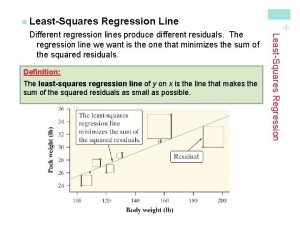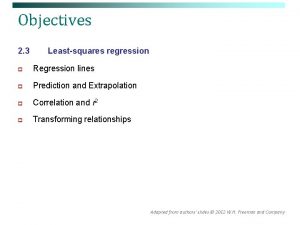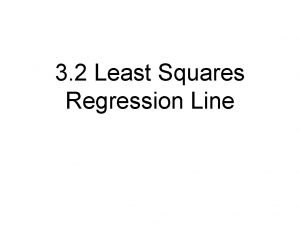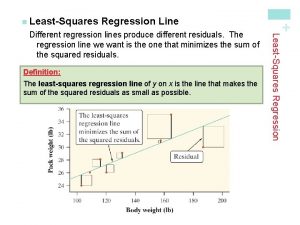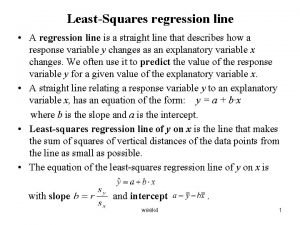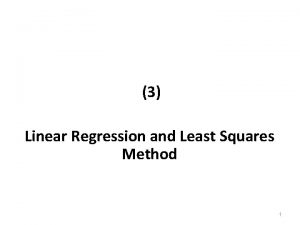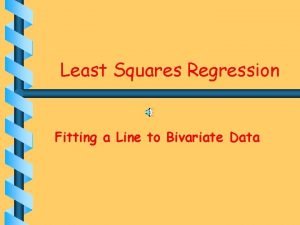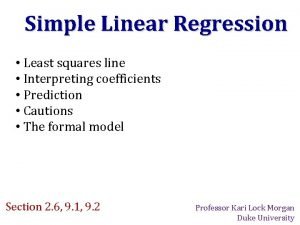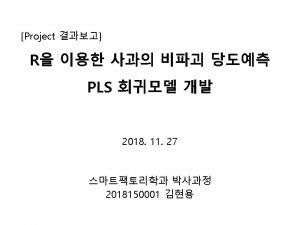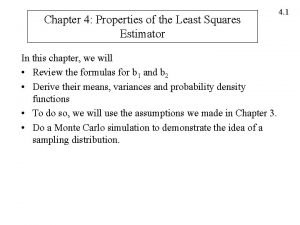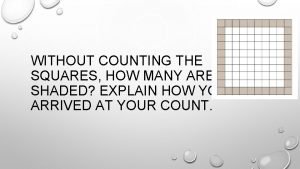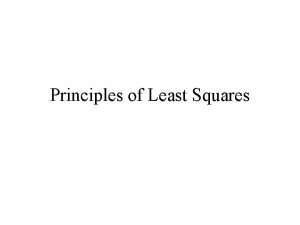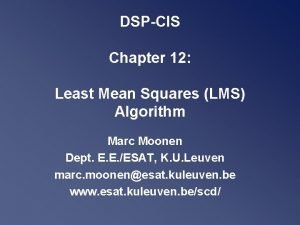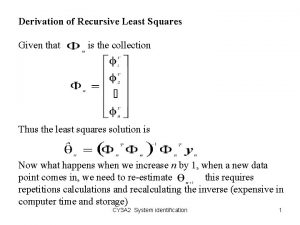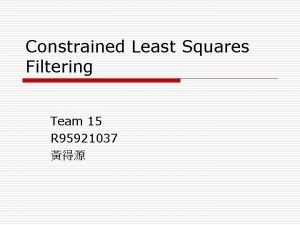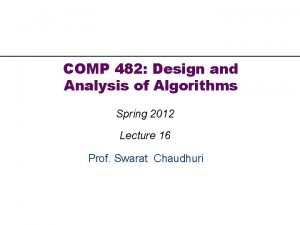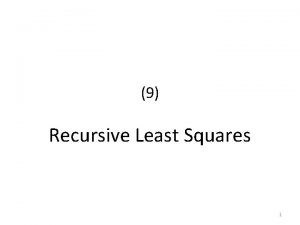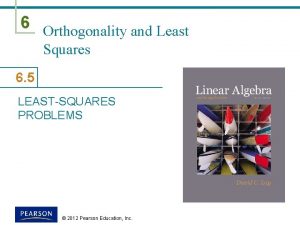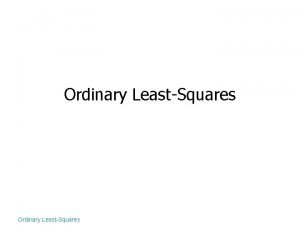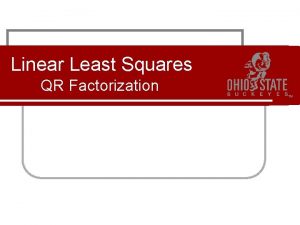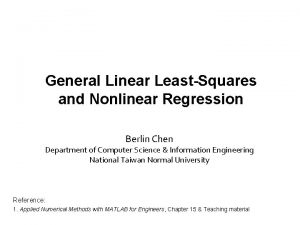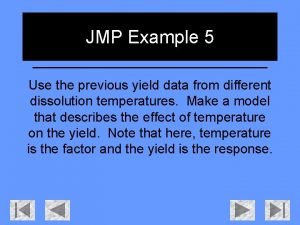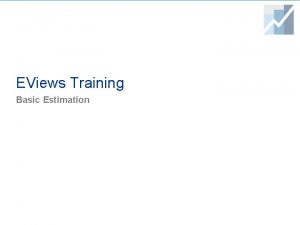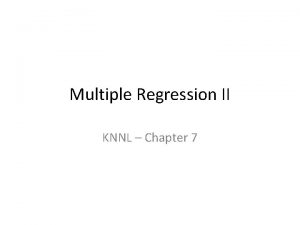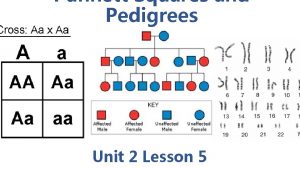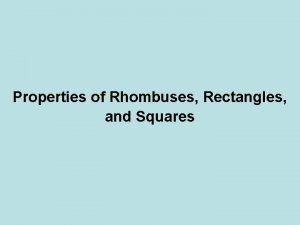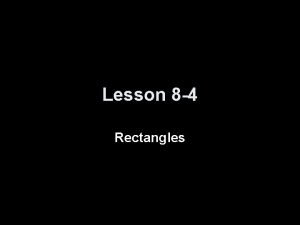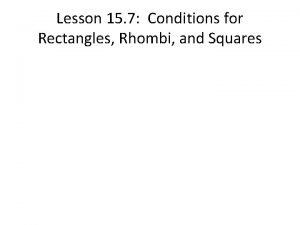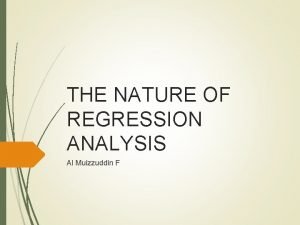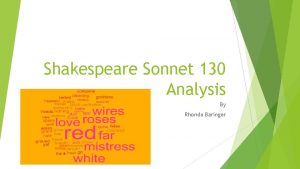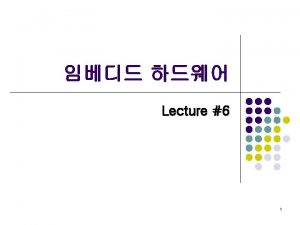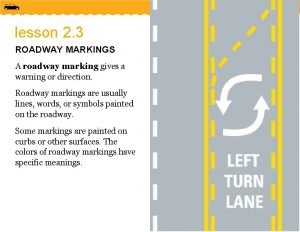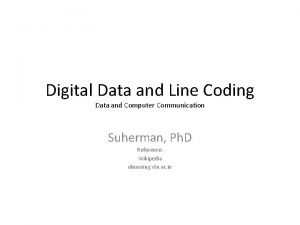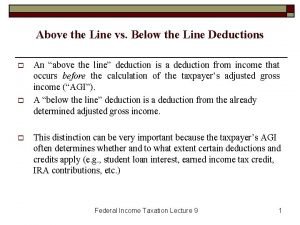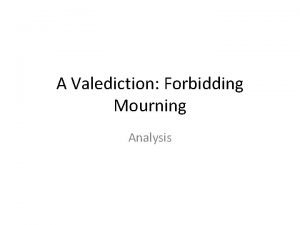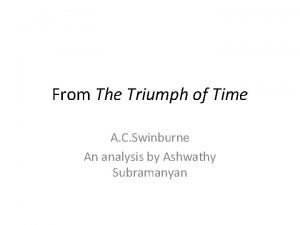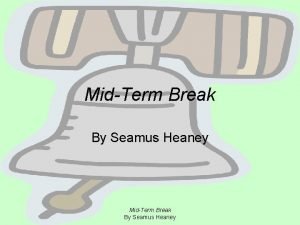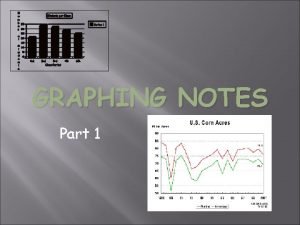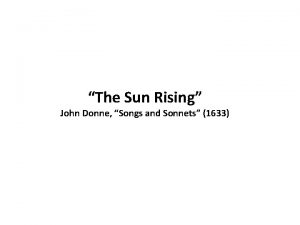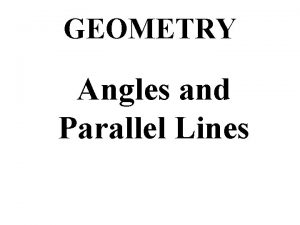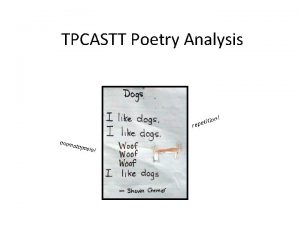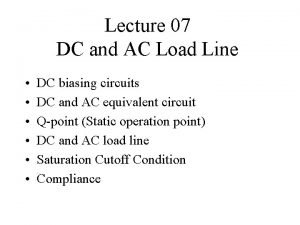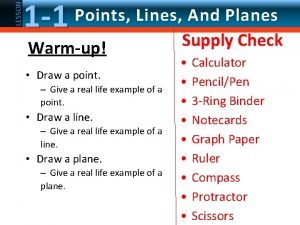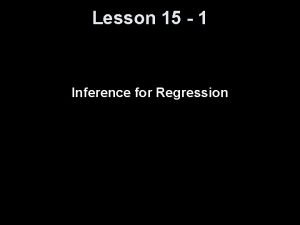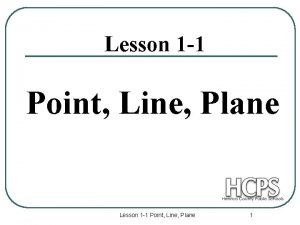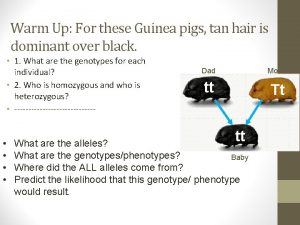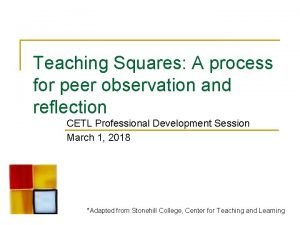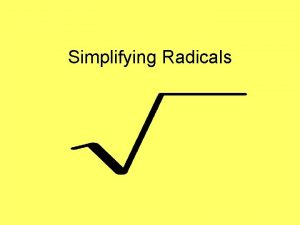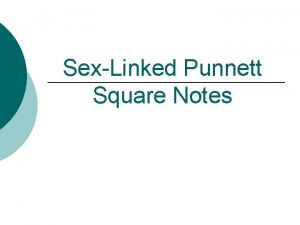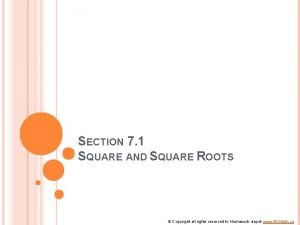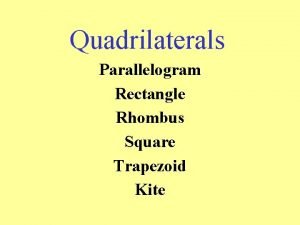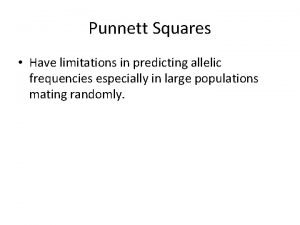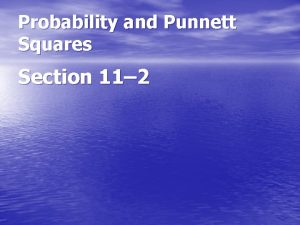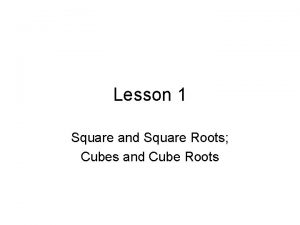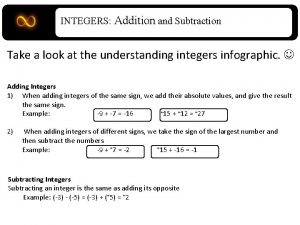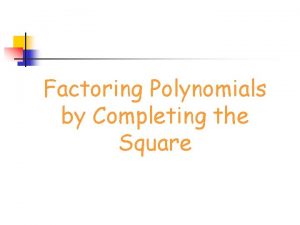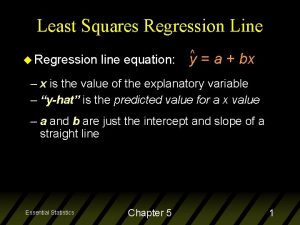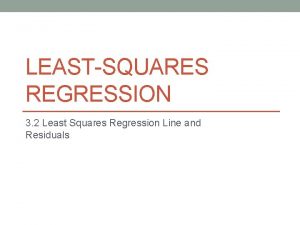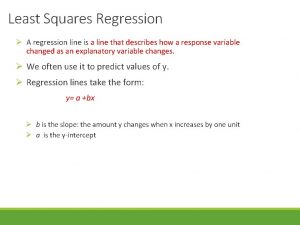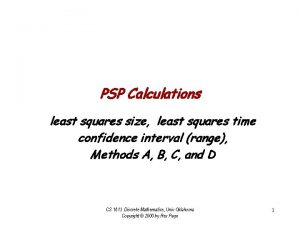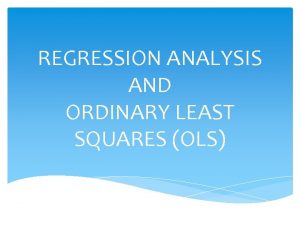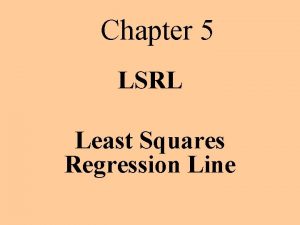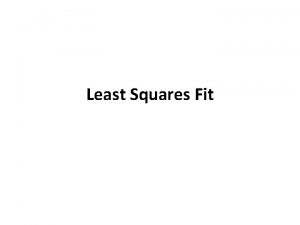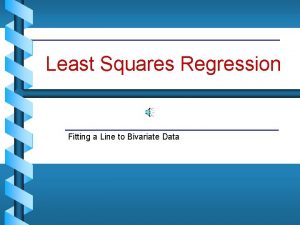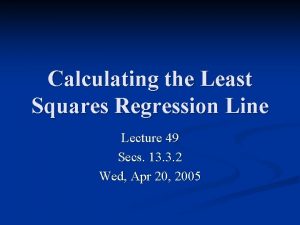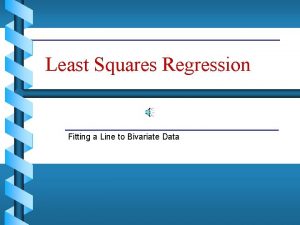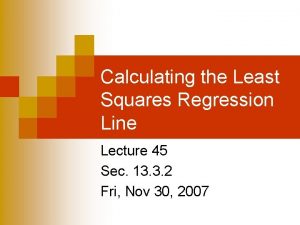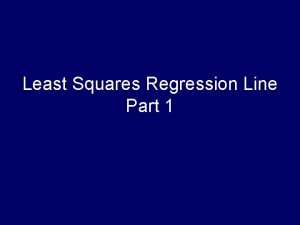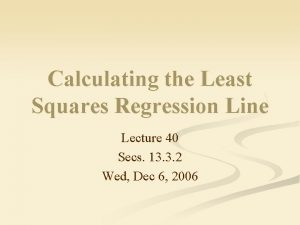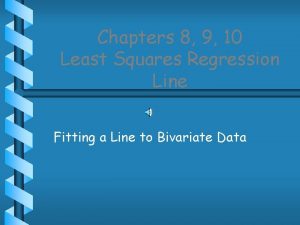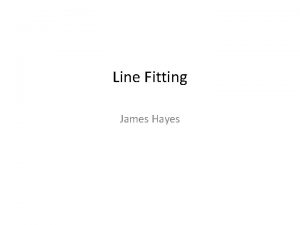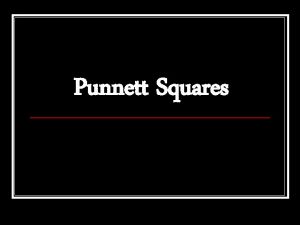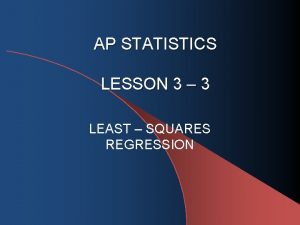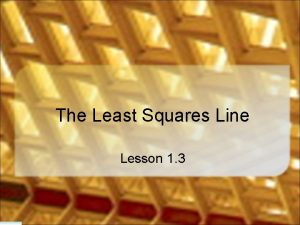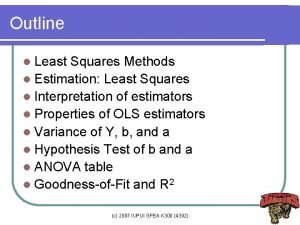Least Squares Regression Line Lesson 3 2 skewthescript







































































































































- Slides: 135

Least Squares Regression Line - Lesson 3. 2 skewthescript. org

skewthescript. org

Do schools in America effectively equalize opportunity for low‐ income students? skewthescript. org

Today’s Key Analysis Will raising attendance also raise scores for low incomes students? skewthescript. org

Lesson 3. 2 Guided Notes Handout: skewthescript. org/3 -2 skewthescript. org

Topics 1. 2. 3. 4. Least squares regression line (LSRL) Slope and y‐intercept Predictions using the LSRL Dangers of prediction skewthescript. org

Topics 1. 2. 3. 4. Least squares regression line (LSRL) Slope and y‐intercept Predictions using the LSRL Dangers of prediction skewthescript. org

The Income Achievement Gap Nationally, low income students perform worse on math exams than middle/upper class students. Source: NAEP (National Assessment of Education Progress) Long‐Term Trend Mathematics scores. Image scale based on NAEP online chart tool. According to NAEP, differences are statistically significant. skewthescript. org

The Income Attendance Gap NYC: High Poverty Areas Have Lower Attendance Rates Nationally, low income areas have more chronically absent students. Graphic from Nauer et al. , “A Better Picture of Poverty, ” Center for New York City Affairs, Nov. 2014: https: //www. attendanceworks. org/wp‐content/uploads/2017/06/Better. Pictureof. Poverty_PA_FINAL_001. pdf skewthescript. org

Correlation? ! skewthescript. org

skewthescript. org

skewthescript. org

Is attendance the solution? Poverty Low Attendance Low Scores skewthescript. org

Is attendance the solution? Poverty High Low Attendance Low Scores skewthescript. org

Is attendance the solution? Poverty High Low Attendance High Low Scores skewthescript. org

Is attendance the solution? Poverty High Will raising attendance Low Attendance also raise scores? High Low Scores skewthescript. org

STAAR Percent Algebra 1 Attendance Raw Score 95 89 67 98 99 76 92 91 76 85 82 45 42 31 51 49 38 46 41 35 39 37 Linear Regression Random sample of students who took the Texas STAAR state Algebra 1 assessment and their attendance rate during the school year. skewthescript. org

explains responds STAAR Percent Algebra 1 Attendance Raw Score 95 89 67 98 99 76 92 91 76 85 82 45 42 31 51 49 38 46 41 35 39 37 Linear Regression Random sample of students who took the Texas STAAR state Algebra 1 assessment and their attendance rate during the school year. skewthescript. org

explains responds STAAR Percent Algebra 1 Attendance Raw Score (x) (y) 95 89 67 98 99 76 92 91 76 85 82 45 42 31 51 49 38 46 41 35 39 37 Linear Regression Random sample of students who took the Texas STAAR state Algebra 1 assessment and their attendance rate during the school year. Explanatory (x): Attendance Response (y): Test Scores skewthescript. org

skewthescript. org

D: Positive O: None F: Linear S: Strong skewthescript. org

Superintendent: “If a student meets our minimum attendance goal (87%), what would their predicted test score be? ” D: Positive O: None F: Linear S: Strong skewthescript. org

skewthescript. org

How do we find the least squares regression line (LSRL)? skewthescript. org

Least Squares Regression skewthescript. org

Least Squares Regression Model A skewthescript. org

Least Squares Regression Model B skewthescript. org

Least Squares Regression Model A skewthescript. org

Least Squares Regression Model B skewthescript. org

Least Squares Regression Model A skewthescript. org

Least Squares Regression Model B skewthescript. org

Model A Model B skewthescript. org

Model A Which model fits better? Model B skewthescript. org

Residual skewthescript. org

(7, 5) Residual skewthescript. org

(7, 5) (7, 3) (7, 5) Residual skewthescript. org

(7, 5) (7, 3) (7, 5) (7, 4) Residual skewthescript. org

(7, 5) (7, 3) (7, 5) (7, 4) Residual skewthescript. org

(7, 5) (7, 3) (7, 5) (7, 4) skewthescript. org

(7, 5) (7, 3) (7, 5) (7, 4) skewthescript. org

(7, 5) (7, 3) (7, 5) (7, 4) skewthescript. org

(9, 4) (9, 3) skewthescript. org

(9, 4) (9, 3) (9, 7) (9, 3) skewthescript. org

(9, 4) (9, 3) (9, 7) (9, 3) skewthescript. org

(9, 4) (9, 3) (9, 7) (9, 3) skewthescript. org

(9, 4) (9, 3) (9, 7) (9, 3) skewthescript. org

First thought: The line of best fit is the line that minimizes the sum of the residuals. skewthescript. org

skewthescript. org

skewthescript. org

Sum of residuals: 0 + 0 = 0 skewthescript. org

Sum of residuals: 0 + 0 = 0 Good fit. skewthescript. org

skewthescript. org

-2 +2 0 skewthescript. org

-2 +2 0 Sum of residuals: 2 + 0 + (‐ 2) = 0 skewthescript. org

-2 +2 0 Sum of residuals: 2 + 0 + (‐ 2) = 0 Good fit? ! skewthescript. org

-2 +2 0 skewthescript. org

skewthescript. org

skewthescript. org

skewthescript. org

skewthescript. org

skewthescript. org

skewthescript. org

Sum of squared residuals 4 + 0 + 4 = 8 Not a great fit Sum of squared residuals 0 + 0 = 0 Great fit! skewthescript. org

Least Squares Regression Line (LSRL): a linear model that minimizes the sum of the square residuals between the data and the model. • Also called “line of best fit” skewthescript. org

How do we find the least squares regression line (LSRL)? skewthescript. org

skewthescript. org

skewthescript. org

skewthescript. org

Calculator steps in later lesson! skewthescript. org

Topics 1. 2. 3. 4. Least squares regression line (LSRL) Slope and y-intercept Predictions using the LSRL Dangers of prediction skewthescript. org

Every mathematician’s favorite one‐liner: y = mx + b skewthescript. org

y = mx + b y = 2 x + 1 Slope? What does it mean? Y intercept? What does it mean? skewthescript. org

y = mx + b y = 2 x + 1 Slope? What does it mean? +1 Y intercept? What does it mean? skewthescript. org

y = mx + b +1 +2 y = 2 x + 1 Slope? What does it mean? Y intercept? What does it mean? skewthescript. org

y = mx + b +1 +2 y = 2 x + 1 Slope? What does it mean? Y intercept? What does it mean? skewthescript. org

y = mx + b +1 +2 y = 2 x + 1 Slope? What does it mean? Slope: 2 For every increase in x by 1 unit, the y values increase by 2. Y intercept? What does it mean? skewthescript. org

y = mx + b y-int y = 2 x + 1 Slope? What does it mean? Slope: 2 For every increase in x by 1 unit, the y values increase by 2. Y intercept? What does it mean? skewthescript. org

y = mx + b y-int y = 2 x + 1 Slope? What does it mean? Slope: 2 For every increase in x by 1 unit, the y values increase by 2. Y intercept? What does it mean? Y-intercept: 1 When x = 0, the y‐value is 1 skewthescript. org

skewthescript. org

skewthescript. org

Slope skewthescript. org

Slope y-intercept skewthescript. org

y‐value predicted y‐value Slope y-intercept skewthescript. org

skewthescript. org

skewthescript. org

skewthescript. org

predicted y‐value y‐intercept Slope skewthescript. org

predicted y‐value y‐intercept Slope skewthescript. org

1) Interpret the slope value… skewthescript. org

1) Interpret the slope value… skewthescript. org

1) Interpret the slope value… For every 1 unit increase in explanatory variable, our model predicts an average increase/decrease of slope in response variable. skewthescript. org

1) Interpret the slope value… For every 1 unit increase in explanatory variable, our model predicts an average increase/decrease of slope in response variable. For every 1 percentage point increase in attendance, our model predicts an average increase of 0. 5669 points in students’ test scores. skewthescript. org

2) Interpret the y-intercept… skewthescript. org

2) Interpret the y-intercept… skewthescript. org

2) Interpret the y-intercept… When the explanatory variable is zero units, our model predicts that the response variable would be y‐intercept. skewthescript. org

2) Interpret the y-intercept… When the explanatory variable is zero units, our model predicts that the response variable would be y‐intercept. When attendance is zero percent, our model predicts that the students’ test scores would be ‐ 7. 689. skewthescript. org

2) Interpret the y-intercept… When the explanatory variable is zero units our model This y‐int value is not meaningful, since predicts that the response variable would be y‐intercept. anyone with 0% attendance doesn’t When attendance is zero percent our model predicts really go to the school or take the exam. that the students’ test scores would be ‐ 7. 689. skewthescript. org

Topics 1. 2. 3. 4. Least squares regression line (LSRL) Slope and y‐intercept Predictions using the LSRL Dangers of prediction skewthescript. org

Superintendent: “If a student meets our minimum attendance goal (87%), what would their predicted test score be? ” skewthescript. org

y = mx + b y = 2 x + 1 Find the y-value when x = 2: skewthescript. org

y = mx + b skewthescript. org

y = mx + b x=2 skewthescript. org

y = mx + b x=2 skewthescript. org

y = mx + b y=5 x=2 skewthescript. org

Superintendent: “If a student meets our minimum attendance goal (87%), what would their predicted test score be? ” skewthescript. org

Superintendent: “If a student meets our minimum attendance goal (87%), what would their predicted test score be? ” skewthescript. org

Superintendent: “If a student meets our minimum attendance goal (87%), what would their predicted test score be? ” x = 87 skewthescript. org

Superintendent: “If a student meets our minimum attendance goal (87%), what would their predicted test score be? ” x = 87 skewthescript. org

Superintendent: “If a student meets our minimum attendance goal (87%), what would their predicted test score be? ” x = 87 skewthescript. org

Topics 1. 2. 3. 4. Least squares regression line (LSRL) Slope and y‐intercept Predictions using the LSRL Dangers of prediction skewthescript. org

Is attendance the solution? Poverty High Will raising attendance Low Attendance also raise scores? High Low Scores skewthescript. org

skewthescript. org

Of course attending school helps! skewthescript. org

Fixing attendance In the past several years, superintendents have piloted large‐scale (and sometimes quite expensive) initiatives to improve student attendance. These included: 1. Call programs for chronically absent students 2. Hiring attendance case managers and coordinators 3. Using Uber/Lyft for students with transportation issues skewthescript. org

The result Attendance Pyne, Grodsky, et al. , (2018). What Happens When Children Miss School? Unpacking Elementary School Absences in MMSD. Madison, WI: Madison Education Partnership. skewthescript. org

The result Test Scores Pyne, Grodsky, et al. , (2018). What Happens When Children Miss School? Unpacking Elementary School Absences in MMSD. Madison, WI: Madison Education Partnership. skewthescript. org

The result Test Scores Pyne, Grodsky, et al. , (2018). What Happens When Children Miss School? Unpacking Elementary School Absences in MMSD. Madison, WI: Madison Education Partnership. skewthescript. org

The result 1. Test scores overall did not rise significantly 2. The achievement gaps remained Pyne, Grodsky, et al. , (2018). What Happens When Children Miss School? Unpacking Elementary School Absences in MMSD. Madison, WI: Madison Education Partnership. skewthescript. org

Lesson 3. 2 Discussion skewthescript. org

Poverty High Low Attendance High Low Scores skewthescript. org

Discussion Question: Why didn’t raising attendance work? Poverty High Low Attendance High Low Scores skewthescript. org

Correlation ≠ Causation skewthescript. org

Is attendance the solution? Poverty Low Attendance Low Scores skewthescript. org

Is attendance the solution? Poverty Low Attendance Low Scores Hunger Worse Schools Less Study Time (job, taking care of family) skewthescript. org

Is attendance the solution? Poverty Low Attendance Low Scores Hunger Worse Schools Less Study Time (job, taking care of family) Cause skewthescript. org

Is attendance the solution? Poverty High Low Attendance Low Scores Hunger Worse Schools Less Study Time (job, taking care of family) Cause skewthescript. org

Is attendance the solution? Poverty High Low Attendance Low Scores Hunger Worse Schools Less Study Time (job, taking care of family) Cause skewthescript. org

Is attendance the solution? Poverty High Low Attendance Low Scores Hunger Worse Schools Less Study Time (job, taking care of family) Cause skewthescript. org

Lesson 3. 2 Practice skewthescript. org

1) Dr. Youfa Wang at University of North Carolina published a study* on obesity in America. Using linear regression, the study concluded that by 2048, if trends continue, 100% of Americans would be overweight. Using the graphs** below, do you believe this conclusion is correct? Why or why not? Example inspired by Ellenberg, J. How Not to be Wrong, pg. 50‐ 61. Model Projection Data and Model *Wang, Beydoun, et al. , “Will all Americans become overweight or obese? estimating the progression and cost of the US obesity epidemic. ” Obesity (Silver Spring). 2008; 16(10): 2323‐ 2330. doi: 10. 1038/oby. 2008. 351 **Graphs provided are representative approximations of analyses from the paper skewthescript. org

Extrapolation: using your model to make predictions outside the range of your data. skewthescript. org

Extrapolation is dangerous because the trend may not continue. Extrapolation: using your model to make predictions outside the range of your data. skewthescript. org

Extrapolation is dangerous because the trend may not continue. This logarithmic model is more reasonable – it’s improbable that every single person in the population would become overweight. skewthescript. org

Side note: A logarithmic fit may be better for the grocery store data from last lesson. Presumably, the grocery chain has an upper limit on the organic options it can provide from its supply chains. skewthescript. org

Side note: A logarithmic fit may be better for the grocery store data from last lesson. Presumably, the grocery chain has an upper limit on the organic options it can provide from its supply chains. skewthescript. org
 Least squares regression line definition
Least squares regression line definition How to find least squares regression line on statcrunch
How to find least squares regression line on statcrunch Least squared regression line
Least squared regression line Statcrunch least squares regression line
Statcrunch least squares regression line Least squares regression line definition
Least squares regression line definition Least squares regression line minitab
Least squares regression line minitab The least square method
The least square method Polynomial regression least squares
Polynomial regression least squares Bivariate least squares regression
Bivariate least squares regression Least squares regression
Least squares regression Ordinary least squares
Ordinary least squares Properties of least squares estimator proof
Properties of least squares estimator proof Youcubed squares and more squares answers
Youcubed squares and more squares answers My age
My age Least square solution
Least square solution Mean ?
Mean ? Recursive least squares derivation
Recursive least squares derivation Constrained least squares filtering
Constrained least squares filtering 4d3d41669541f1bf19acde21e19e43d23ebbd23b
4d3d41669541f1bf19acde21e19e43d23ebbd23b Least squares example
Least squares example Orthogonality and least squares
Orthogonality and least squares Least square solution
Least square solution Qr factorization least squares
Qr factorization least squares Approximation de padé
Approximation de padé Least squares matrix
Least squares matrix Fit least squares jmp
Fit least squares jmp Weighted least squares eviews
Weighted least squares eviews Extra sum of squares multiple regression
Extra sum of squares multiple regression Simple multiple linear regression
Simple multiple linear regression Multiple linear regression
Multiple linear regression Survival analysis vs logistic regression
Survival analysis vs logistic regression Logistic regression vs linear regression
Logistic regression vs linear regression Principle of surveying
Principle of surveying Pedigree and punnett square
Pedigree and punnett square 6.5 conditions for rhombuses rectangles and squares
6.5 conditions for rhombuses rectangles and squares 6-4 rectangles answers
6-4 rectangles answers 15.7 conditions for rectangles rhombuses and squares
15.7 conditions for rectangles rhombuses and squares Median regression line
Median regression line Properties of regression line
Properties of regression line Ulysses analysis line by line
Ulysses analysis line by line To daffodils by robert herrick analysis line by line
To daffodils by robert herrick analysis line by line Thou blind man's mark theme
Thou blind man's mark theme Sonnet 14 lines examples
Sonnet 14 lines examples Harsh thunder of imperial power meaning
Harsh thunder of imperial power meaning Sonnet 60 by william shakespeare summary
Sonnet 60 by william shakespeare summary Sonnet 130 summary line by-line
Sonnet 130 summary line by-line Shakespeare 57 sonnet
Shakespeare 57 sonnet Sonnet 64 analysis
Sonnet 64 analysis Cellbit meaning
Cellbit meaning The romeo and juliet prologue
The romeo and juliet prologue Farewell love theme
Farewell love theme Thunderstorm poem
Thunderstorm poem What is the tone of the poem burning a book
What is the tone of the poem burning a book Metaphor nothing gold can stay
Metaphor nothing gold can stay Money madness poem pdf
Money madness poem pdf Solid yellow line and broken yellow line
Solid yellow line and broken yellow line Apostrophe to the ocean
Apostrophe to the ocean Thou blind man's mark analysis line by line
Thou blind man's mark analysis line by line Futility summary
Futility summary Out, out analysis
Out, out analysis Dream black boy poem
Dream black boy poem Line coding adalah
Line coding adalah Count the day lost summary
Count the day lost summary Above the line vs below the line
Above the line vs below the line A valediction forbidding mourning structure
A valediction forbidding mourning structure One self i sing analysis
One self i sing analysis What type of drawing do we use miter line?
What type of drawing do we use miter line? Simulation dissimulation
Simulation dissimulation Poetic devices in tintern abbey
Poetic devices in tintern abbey Swinburne
Swinburne African thunderstorm poem
African thunderstorm poem Nicene creed holy trinity
Nicene creed holy trinity The rime of the ancient mariner analysis line by line
The rime of the ancient mariner analysis line by line She dwelt among the untrodden ways text
She dwelt among the untrodden ways text Vibrating line and fovea palatini
Vibrating line and fovea palatini Waving not drowning meaning
Waving not drowning meaning Construct parallel lines
Construct parallel lines Ozymandias poem explanation with quotations
Ozymandias poem explanation with quotations O captain my captain symbolism
O captain my captain symbolism My galley charged poem summary
My galley charged poem summary Poem for my mother jennifer davids line by line analysis
Poem for my mother jennifer davids line by line analysis Mid term break conclusion
Mid term break conclusion Just me poem
Just me poem Vertical line and horizontal line
Vertical line and horizontal line Full moon and little frieda summary
Full moon and little frieda summary Frost at midnight analysis
Frost at midnight analysis What is floral
What is floral Horses by ted hughes
Horses by ted hughes Dulce et decorum est structure
Dulce et decorum est structure Objectives of flower arrangement
Objectives of flower arrangement Operating line and equilibrium line in absorption
Operating line and equilibrium line in absorption Accordion hose load
Accordion hose load Tonight i can write line by line analysis
Tonight i can write line by line analysis Posterior palatal seal function
Posterior palatal seal function Hands search my empty pockets
Hands search my empty pockets I will embrace only the sun explanation
I will embrace only the sun explanation Bioblique astigmatism
Bioblique astigmatism An extension line should any line.
An extension line should any line. Slope of budget line or price line is
Slope of budget line or price line is A prayer for all my countrymen poem pdf
A prayer for all my countrymen poem pdf A hard frost
A hard frost Sun rising john donne
Sun rising john donne Romeo and juliet prolouge
Romeo and juliet prolouge Line vw and line xy are parallel lines drawing
Line vw and line xy are parallel lines drawing All the angles
All the angles Poem tpcastt example
Poem tpcastt example Lake isle of innisfree rhyme scheme
Lake isle of innisfree rhyme scheme Sonnet 18 rhyme scheme
Sonnet 18 rhyme scheme The point of intersection of dc and ac load line is called
The point of intersection of dc and ac load line is called Capital allocation line vs capital market line
Capital allocation line vs capital market line Lesson 1-1 understanding points lines and planes
Lesson 1-1 understanding points lines and planes Lesson 1-1 points, lines, and planes answers
Lesson 1-1 points, lines, and planes answers Assembly line lesson plan
Assembly line lesson plan A line with no end point
A line with no end point 1-2 line segments and distance answer key mcgraw hill
1-2 line segments and distance answer key mcgraw hill Lesson 15 interpreting residuals from a line
Lesson 15 interpreting residuals from a line Lesson 1 point line and plane
Lesson 1 point line and plane Pyr
Pyr Greatest common factor of 60
Greatest common factor of 60 Teaching squares
Teaching squares Is 256 a perfect square
Is 256 a perfect square Perfect square activity
Perfect square activity 225/16 square root
225/16 square root Simplify square root of 4/9
Simplify square root of 4/9 Sex linked trait punnett square
Sex linked trait punnett square What are all of the perfect squares
What are all of the perfect squares Are all parallelograms quadrilaterals
Are all parallelograms quadrilaterals Punnett square
Punnett square 11-2 probability and punnett squares
11-2 probability and punnett squares Polygon heirarchy
Polygon heirarchy Perfect squares notes
Perfect squares notes Punnet square
Punnet square Is 72 a perfect square
Is 72 a perfect square List of perfect squares
List of perfect squares How to do dihybrid cross
How to do dihybrid cross Perfect square trinomial formula
Perfect square trinomial formula
